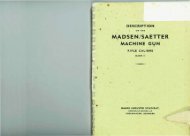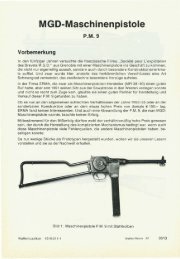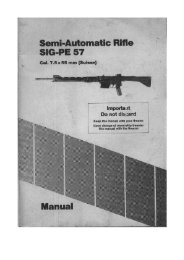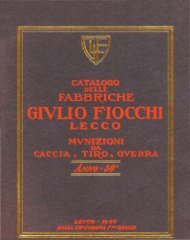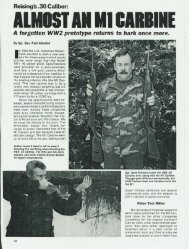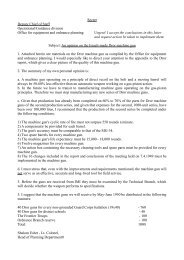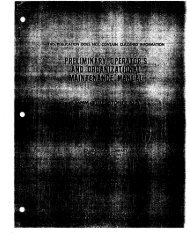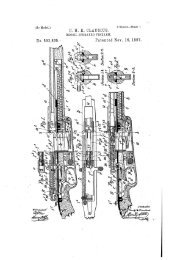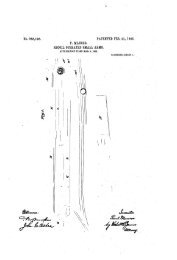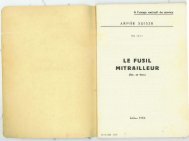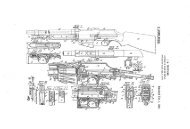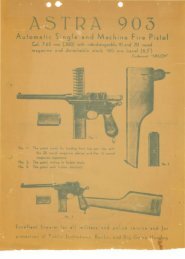8 inc Howitzer manual.pdf - Replica Plans and Blueprints
8 inc Howitzer manual.pdf - Replica Plans and Blueprints
8 inc Howitzer manual.pdf - Replica Plans and Blueprints
You also want an ePaper? Increase the reach of your titles
YUMPU automatically turns print PDFs into web optimized ePapers that Google loves.
27<br />
when elevating the howitzer, the actuating rod pulls upon the short<br />
lever, rotating the cross spindle, bevel segments, piston rod, <strong>and</strong> piston,<br />
thereby decreasing the orifice between the ports in the piston <strong>and</strong> the<br />
recoil valve, which is held fast by i ts keys <strong>and</strong> grooves in the cylinder.<br />
This <strong>inc</strong>reases the resistance set up in the recoil cylinder dming recoil,<br />
thereby shortening the recoil of the howitzer. The recoil varies from<br />
60 <strong>inc</strong>hes, howitzer horizontal, to 24 <strong>inc</strong>hes at 50° elevation, or 0.72<br />
<strong>inc</strong>h per degree of elevation.<br />
UECtJPERATOR.<br />
(Plate XIU.)<br />
The recuperator is of the hyclropneumatic pr<strong>inc</strong>iple <strong>and</strong> consists of<br />
two liquid cylinders in which work rams, <strong>and</strong> two air cylinders which<br />
contain both liquid <strong>and</strong> compressed air. The air cylinders are connected<br />
at their rear ends by an equalizing passage, <strong>and</strong> are also connected<br />
to the front end of the liquid cylinders by an annular recess<br />
around the latter, along which the liquid passes on recoil <strong>and</strong> counterrecoil.<br />
The liquid cylinders are closed at the rear end by perforated caps<br />
which are held by pins. The perforations allow any liquid which may<br />
get by the piston to get clear, otherwise the howitzer wo uld not return<br />
fully to firing position after recoil. They also prevent a vacuum forming<br />
in the rear of the recuperator ram.<br />
The front ends are closed by stuffing boxes, packing <strong>and</strong> caps in<br />
much the same manner as the recoil cylinder. Internally near its<br />
front end, each cylinder is reduced in diameter to form a seat for a<br />
throttle valve, which fits loosely around the piston rod <strong>and</strong> is kept to<br />
its seat by a helical spring, one end of which bears against the valve <strong>and</strong><br />
the other end against the inner face of the stuffing box.<br />
The valves are provided with a coned bead to fit tightly on their<br />
seat. Holes are bored through the head to allow liquid to pass back<br />
into the cylinders after recoil.<br />
The recuperator piston rods are of steel ; their front ends are seemed<br />
by a screwed sleeve inside <strong>and</strong> a nut ou tside to the cradle cap, while<br />
their inner ends are provided with a packed piston. The packing consists<br />
of two U-shaped leathers properly h eld by supporting rings <strong>and</strong><br />
secured by a nut, also a ring of h emp packing, which is kept tightly<br />
against the piston proper by a helical spring h eld by a nut.<br />
The piston rods are hollow; <strong>and</strong> the front end of each is prepared to<br />
take an adapter to which the pipe fro m the charging cup is connected<br />
when filling. A small side hole at the rear connects the interior of the<br />
rod with the liquid cylinders. When the adapter is not in use, the<br />
opening at the front is closed by a plug.




